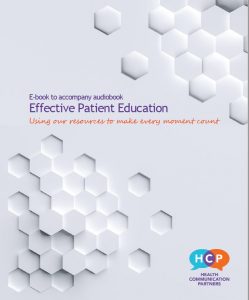Patient education is a cornerstone of care. You see many patients in a day and have a high level of complexity to deal with. Your patient education is also expected to achieve multiple simultaneous goals, under increasingly restricted circumstances.
A nurse administrator asked me the question that’s the title of this article. It’s no secret that time is the ultimate constraint. Everywhere I go, everyone in healthcare wants to talk about time.
Both patients and providers seem to want more time. This much-maligned 15 minute ‘rule’ has been traced back 25 years to Medicare’s implementation of the RVUs. Other providers are seeing patients in 11 minutes, 8 minutes, or less.
Yet when I talk to providers they also say they want their patient education to to make a difference to what the patient does, and how the patient feels, when they leave.
Time is short. Education is a complex endeavor. And there’s a great deal at stake.
When one size doesn’t fit all
It’s understandable that providers want to make patient education as effective and efficient as possible. Despite the allure of having a one-size-fits-all script that’s delivered to every patient, people live–and learn–differently.
Because of variations in people’s lifestyles, goals, and resources, a message that resonates with one patient may largely miss another.
For example, one anesthesiology practice I talked to had developed an educational intervention, with great care, and used it faithfully. Things would usually go well. But when they didn’t, the practice would often only find out after the fact, through phone calls, emails, or survey responses.
“Patients,” a physician remarked, “don’t come standardized.”
Trial and error is not a terribly attractive alternative when it comes to education. For starters, it’s inefficient. More importantly, no one wants to risk leaving patients without what they need.
It’s hard to overstate how important patient education is during the medical encounter. I want to be careful not to oversimplify a very complicated set of problems. But it is possible to be more effective in your patient education–so you get more done, and the patient knows more.
Small changes add up
When you can be more effective with the time you have, you are usually also more efficient in the larger picture.
As one oncologist told me, “Small changes in each block of time add up” across a day.
And, as the anesthesiology practice knew, time is saved when patients have fewer questions after the visit, or fewer misunderstandings about the actions they should take.
I have created a bundle of resources that will help you to apply proven educational principles to your patient education, in order to get your message across and support positive health outcomes.
These materials are based on educational principles that reach all learners and are culturally and linguistically appropriate. They address health communication and health literacy concerns as well.

Effective Patient Education Audiobook Bundle
This bundle of audiobook, eBook, and supplementary materials will help make your life easier. And it might change the way you think about patient education, no matter your specialization or patient population. You get practical, culturally and linguistically relevant advice and research-based tools, in an unfussy, conversational format. All sales support this podcast series.
$19.99
Buy Now
Not ‘one more thing’
This is not about adding one more thing to your already crowded day. It’s about improving what are you already doing, making your day better, and increasing your effectiveness.
The materials here will help you look at what you are already doing, in ways that will show you what you can do differently to be more effective. You maintain your own style, your own preferred way of educating.
You get:
- an 80 minute audiobook (listen where and when you want)
- a 43 page eBook with linked research references
- 12 pages of supplemental materials
- a bonus planning guide
This is about setting goals for your encounter. About breaking down complex topics to prepare yourself to really reach individual patients.
It’s also about strategically listening to and learning from your patient so you don’t waste anyone’s time.
I’ll tell you how to rescue an educational interaction when it’s all going wrong, and finally, we take a look at assessing in a way that captures what matters. You can get the Effective Patient Education Audiobook Bundle here.
Patient education that doesn’t talk down to people
You want to make the most of the short time you have with patients. You want to be effective. But you don’t want to talk down to people in the meantime. This is patient education from a resource-based perspective.
No matter your specialization. No matter who you’re educating. No matter what standards or metrics you use.
Real world tools for use in clinical practice
The eBook has loads of links to further reading and relevant research. Don’t miss the exclusive support materials too – I made these for you. They include checklists, graphic organizers, prompts, and more – to keep you on track and keep it real.
It’s exclusive – I made it just for you – and its flexible format keeps it user-friendly. So you can level up your educator game on your own schedule.
Oh, and it’s affordable too.
$19.99
